

Educational Leadership:Common Core: Now What?:Closing in on Close Reading. Blog-a-thon Post 1: What #CloseReading Isn’t (Or At Least Shouldn’t Be) Welcome to the first post in our 7-week blog-a-thon on #closereading.

We invite YOU to join in! Find more on how-to here. Several selected posts will be linked to on the Contributors page. Let’s closely read the practice of close reading together! Close Reading Isn’t Just Anything Just as I suddenly–and against my will–have now heard hundreds of people use the term “twerking” in near constant use, from the VMAs to news anchors to walking into the grocery store… and I don’t think everyone is using it correctly (if you don’t know the definition, please do not hold me accountable for what you google)…, it seems that once a term comes in vogue everyone uses it to define everything.
Strategies for Close Reading. By Samantha Cleaver Let’s face it, close reading isn’t often a skill that comes naturally.
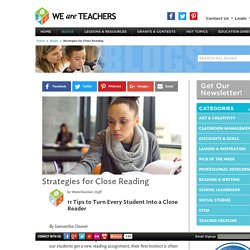
When our students get a new reading assignment, their first instinct is often to race to the finish line rather than engage deeply with a text. Getting students to slow down, engage with the text in different ways, and reflect as they read are challenges for every teacher, and are the goals of close reading. They’re also at the heart of the Common Core English Language Arts standards. There’s no magic way to turn your class into top-notch readers overnight, but there are specific close reading skills you can teach that will help your students now and down the line.
In Harlem, NY, Mark Gillingham, senior researcher with the Great Books Foundation, watches a group of seventh-grade students reading aloud “The White Umbrella.” The key is learning how to annotate effectively. Nurturing these higher-level skills takes time and many different techniques. Close reading in elementary schools. Educational Leadership:Common Core: Now What?:Closing in on Close Reading. A Non-Freaked Out, Focused Approach to the Common Core - Part 3 - Close Reading - Dave Stuart Jr. Update from Dave: Welcome to one of the most popular posts on the blog.
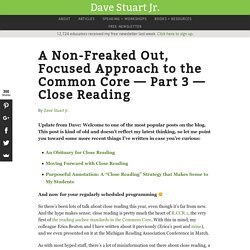
This post is kind of old and doesn’t reflect my latest thinking, so let me point you toward some more recent things I’ve written in case you’re curious: And now for your regularly scheduled programming So there’s been lots of talk about close reading this year, even though it’s far from new. And the hype makes sense; close reading is pretty much the heart of R.CCR.1, the very first of the reading anchor standards in the Common Core. With this in mind, my colleague Erica Beaton and I have written about it previously (Erica’s post and mine), and we even presented on it at the Michigan Reading Association Conference in March. As with most hyped stuff, there’s a lot of misinformation out there about close reading, a lot of “beating texts with a hose” just for the sake of doing it, stuff that confuses kids and makes reading weird and unnatural.
It’s not terribly sexy. [That’s an awkward question.] Never miss an article. Modeling Close Reading for Future Teachers: ELA Videos and Webinars. In my previous post, I shared how I use freely available video in my reading and literacy methods course to help my preservice teachers (PTs) understand close reading instruction at a level that could not be attained through reading and discussion alone.
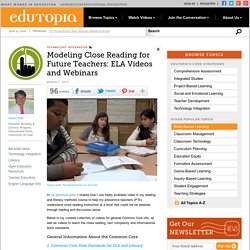
Below is my curated collection of videos for general Common Core info, as well as videos to teach the close reading, text complexity and informational texts standards. General Information About the Common Core 1. Common Core State Standards for ELA and Literacy This 15-minute video gives a general overview of the CCSS and explains why the U.S. has moved to the Common Core. 2. This is a set of cartoon drawings that explain the different organizations and institutions involved in developing the CCSS. Close Reading Packs. Why Use Close Reading Packs Self-directed individual work, team-oriented small-group work, and teacher-facilitated, whole-class discussion helps students analyze and evaluate literary and informational text, with the goal of determining the best answer to a text-dependent Key Question.
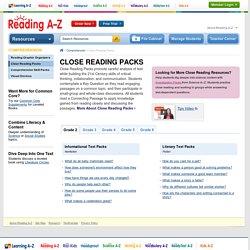
How to Use Close Reading Packs Each pack contains Teaching Tips that address important Common Core skills, such as comprehension, author's craft, and critical thinking. The Teaching Tips also provide teachers with pointers for serving as discussion facilitators as they help students reach consensus on their answer to the Key Question. Student Passages. Common Core: Close Reading. Reading about Close Reading • Notice & Note by Kylene Beers and Robert E.
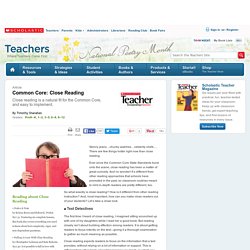
Probst. $27.31. Featuring six complete lessons, this book also covers everything you need to know about text complexity, rigor, and text-dependent questions. • Falling in Love With Close Reading by Christopher Lehman and Kate Roberts. $22.50. Close Reading Power Point. Close Reading Slideshare. Close Reading Anchor Chart. Close Reading Posters. Close Reading Chart. Close Reading Anchor Chart.
CloseReading.